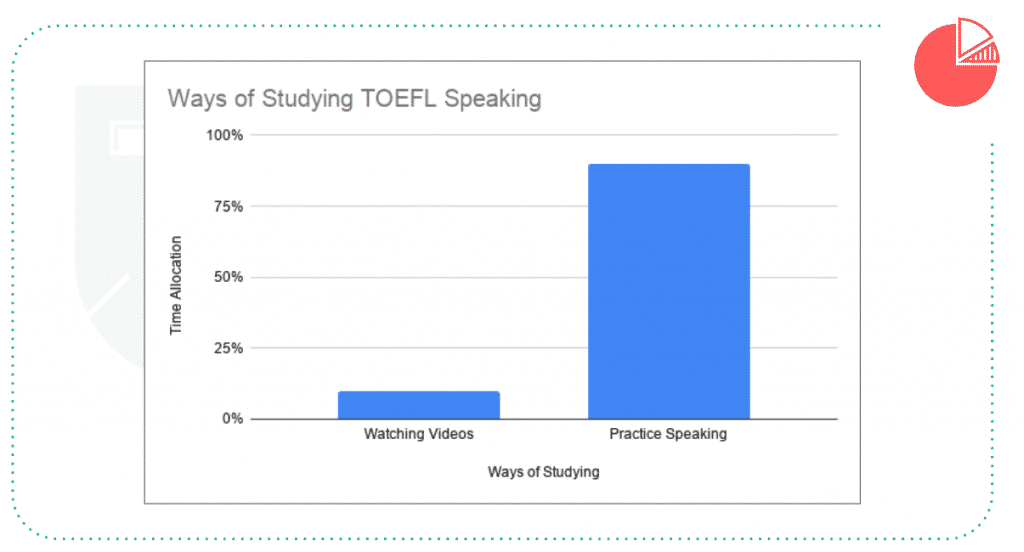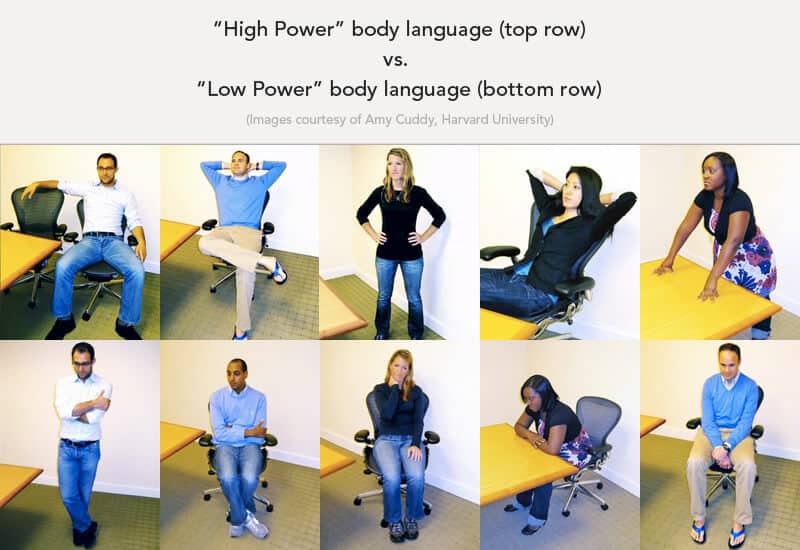- Time management
- Response templates
- Grading criteria
- Question types
- How to improve your TOEFL Speaking score
- How to practice at home
- How to find a friend to practice with
- How to deliver high-scoring speaking responses on test day
- How to stop listening and start speaking
Here they are:
- Tip #1 - Practice instead of watching videos
- Tip #2 - Record your voice
- Tip #3 - Use a grading rubric to analyze your response
- Tip #4 - Find a study buddy
- Tip #5 - Move your hands when you speak
- Tip #6 - Pick the right time and place when you study
- Tip #7 - Start the same way for each question type every time
- Tip #8 - Use a timer
- Tip #9 - Take advantage of speech-to-text technology
- Tip #10 - Get professional support from an experienced teacher
Speaking Tip #1: Practice instead of watching videos
Ok, we get it. When you are tired, it is all too easy to just hit that play button and let the video do the talking for you. And this is a great start…
…but it is only a start.
Do you remember learning how to drive a car? You might have watched a few videos to help prepare you for getting behind the wheel, but you learned a lot more once you sat in the driver’s seat and stepped on the gas.
There is only so much you can learn from a video.
True improvement will come through active thought and consistent practice on your TOEFL Speaking skills. Check out the graph below.

This may sound extreme, but the implications are HUGE. If you only have 10 minutes a day to practice speaking, 9 minutes should be spent working on your responses and just 1 minute on watching videos about the TOEFL Speaking.
Real growth comes through practice.
Wait… so you’re saying to score higher on the speaking test, I will actually have to practice speaking aloud?
Yep, that’s right.
Wondering where to find TOEFL Speaking practice questions?
Check out our complete TOEFL Speaking test video that copy the structure and style of the TOEFL.
Speaking Tip #2: Record your voice
This might be the most important of the TOEFL Speaking tips.
Think of recording your voice like a stage rehearsal before a play. You don’t want to make all your mistakes on stage in front of everyone, right? So, practicing clear and correct pronunciation is a must before taking the actual test.
Is there an app for that? You bet!
Most smartphones come with a voice recorder app already built in, such as Voice Memos for iPhone or Voice Recorder for Samsung.
Want to save your voice in the cloud? Apps like Evernote have a feature that allows you to store your voice in the cloud – for free.
This way you can monitor your speaking patterns by playing back the recording.
Plus, it helps to avoid the awkwardness of practicing in front of other people. With a recorder, you can study alone at home, while you walk to the park, or even while sitting on the toilet at work! (Just make sure no one is using the stall next to you. They might be a spy. Or just think you are weird.)
Another option is to share your voice recording with a friend.
This works for a lot of people.
Most popular chat apps like WhatsApp, Messenger, WeChat, KakaoTalk, and Telegram all have a voice recording feature. Just press the button, record your message, and it sends it automatically.
If you can’t find a friend to help, try an app like HelloTalk to find a native speaker friend and get free feedback on your voice recordings. Of course, this feedback will not be nearly as helpful as a lesson with one of our TOEFL teachers – but it works as a stop-gap between your lessons with us.

Speaking Tip #3: Use a grading rubric to analyze your response
The TOEFL doesn’t seem fair sometimes. You can prepare for the test, but you never know the type of questions you will be asked on test day.
However, no matter what questions you get in the speaking section, the grading rubric remains the same.
Here it is – the actual ETS speaking test rubric.
Grading rubrics help you see things from the grader’s perspective. You can actually hack into the grader’s mind and know exactly what criteria they are looking at when they score your TOEFL Speaking test.
Sneaky, right?
Need a checklist that’s a little easier to read? Download our Speaking and Writing Grading Rubrics checklist for students like you studying on your own.
Independent Speaking Checklist |
|
|---|---|
| Questions | Notes |
| 1. Did I speak for 42-45 seconds? | |
| 2. Was my introduction 12 seconds or less? | |
| 3. Did I have enough time to include a short conclusion (7 seconds or less)? | |
| 4. Did I look at the clock to monitor my time at least twice? | |
| 5. Did I include at least two transitional words or phrases? | |
| 6. Did I speak at a smooth and even pace for the majority of my response? | |
| 7. Did I speak in a natural and conversational tone (no robot voice)? | |
| 8. Did I elaborate on the topic with a well developed personal example or anecdote? | |
Speaking Tip #4: Find a study buddy
Often all we need to stay motivated is to have a friend to share the journey with.
You can check out this Facebook group with over 100,000 TOEFL takers. You might be able to find a like-minded student who is ready to work hard for their TOEFL score.
But if you’re in a hurry, one of the best sources of inspiration is a teacher who can address your weaknesses, support your study habits, and provide you with feedback every step of the way.
You can learn more about our team of TOEFL teachers here.
Speaking Tip #5: Move your hands when you speak
This may be one of the easiest TOEFL speaking tips to implement. When you move your hands while speaking, you become more open and expressive. You may be stuck trying to find the right words, but as you do the motion with your hands, it suddenly hits you – that’s the word I was looking for!
This is especially good for tactile learners, who speak better when using their hands.
Sounds strange? Recent studies have shown that moving your hands when you speak can help you remember difficult words.
Ready to take things to the next level with body language? Check out these high and low power poses from Amy Cuddy’s TED Talk.

The poses on the top row are “high power” poses that can increase your confidence, while the “low power” poses on the bottom can decrease your confidence and have a negative impact on your speaking.
Be sure to position your body in a way that maximizes your confidence on test day. And that includes moving your hands when you speak.
This one little piece of advice could have a major impact on your performance on test day.
Speaking Tip #6:Pick the right time and place when you study
Everyone has a different study schedule that works best for them. Are you a morning person? Study in the morning. Are you a night person? Study at night.
The important thing is that you set aside quality time where you can focus on studying just one thing: TOEFL Speaking. Ideally, this will be a time and place free of distractions.
You will need to do some planning in advance. Write it in your calendar – the specific date, time, and place when you will commit to studying. Then, when that hour comes, go to your chosen study place, turn off those notifications, and focus solely on speaking practice.
Can’t stop checking your phone?
Put your phone in airplane mode or silent mode, or use an app called Cold Turkey to disable distracting internet sites during specified time periods.
This worked for me when I was studying Spanish in college.
Speaking Tip #7: Start the same way every time for each question type
Knowing how to start your response is often the hardest part of the speaking section. Possessing an arsenal of sentence starters in your back pocket can really increase your chances of scoring high.
There are only four tasks – one independent, and three integrated.
The more you practice with each question type, the more comfortable you will become with the structure.
Check out our introductory phrases from our Templates and Strategies for TOEFL Speaking 26+ guide.
Introductory Phrases |
|
|---|---|
| #1 |
|
| #2 |
|
| #3 |
|
| #4 |
|
Speaking Tip #8: Use a timer
- 15 seconds to prepare your response, and
- 45 seconds to speak for each question
- 30 seconds to prepare, and
- 60 seconds to speak for each question. (for question four you only get 20 seconds to prepare)
- Read the speaking prompt
- Set your timer for 60 seconds
- Spend 15 seconds preparing your response
- Spend 45 seconds responding
- Read and listen to the speaking prompt
- Set your timer for 90 seconds (80 seconds for question four)
- Spend 30 seconds preparing your response (20 seconds for question four)
- Spend 60 seconds responding
Speaking Tip #9: Take advantage of speech-to-text technology
Use speech-to-text technology to get instant feedback on your responses
Speaking Tip #10: Get professional support from an experienced teacher
- structured speaking practice
- live feedback on your spoken English
- personalized study plans
Conclusion
That means you care about your score, and you are the exact type of student that we love to help.
Let us know what you thought about our TOEFL Speaking Tips.
Did we miss anything?
Which tip did you find most helpful?
Let us know in the comments section below.
And don’t be a stranger. You can ask us anything at contact@tstprep.com
See you soon













10 Comments
Englay
Hi Mr. Josh
I want your TOEFL PDF(#12)
Josh Macpherson
Hi there Englay, and I think this is the link you are looking for. I hope it helps – https://drive.google.com/drive/u/1/folders/1nCHX-7yp94ovU6_CygYMza1IY7fhqBM-
Marilia Ribeiro
Mr. Josh your articles and videos are awesome. Congratulation for all the work. The videos are so actively encourage me to keep calm and learning. Thank you so much.
Josh Macpherson
Thanks for the compliment! TOEFL can get pretty dry sometimes so I try to keep it light. Much appreciated 🙂
Rahmah Fitri
This website really helpful, i really appreciate that you make this website to us who wanna learn for the TOEFL score. Thank you
Josh Macpherson
Thank you for the support! Much appreciated.
Nisrine
These tips are really helpful thanks
Josh Macpherson
Thanks for commenting! Glad you found it helpful 🙂
Vamsi
Your content proved to be extremely useful in my prep. Your speaking templates were the only reason I was able to score a 28. Thanks much.
Elifozvaris11gmail-com
Thanks a lot Josh!